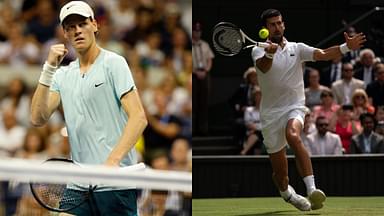After all the talk about Novak Djokovic never losing an Australian Open title after reaching the semi-final, the unbelievable has happened. Italian star Jannik Sinner has breached Djokovic’s fortress and stormed his way into the finals of the Australian Open for the first time. This also calls for Eurosport’s Barbara Schett’s early prediction about Sinner dethroning Djokovic for the title, which might happen in the final. However, fans were more intrigued about what are the tennis tie break rules especially at the Australian Open after Novak Djokovic extended the match perhaps longer than it should have ended.
After dominating the first two sets, Sinner lost the third set against the all-time highest Grand Slam winner. However, this set too was well-fought and lost after a tie. Now, what happens during a tie break and what are tennis tie-break rules? Here’s a brief guide.
‘What are Tennis Tie Break Rules?’ has been doing the rounds on social media after the tied set between Djokovic and Sinner. To understand a tie-break, let’s start with the score after which a set will indefinitely go to a tie-break – a score of 6-6. Usually, the first player to win 6 games wins the set. But there has to be a difference of two points such as 6-4. A 6-5 scoreline will lead to another set, which is the ultimate set if the leading player wins it and the score is 7-5.
However, if the player with 5 games wins the set, then the score is tied at 6-6. From here on starts the tie-breaker. To win that tie-break, a normal numbering system is followed and the player who reaches 7 points first, wins. However, once again the difference has to be of 2 points, even in the tie-breaker. So, if the tie-breaker score is 7-6, then the tie continues, as it has many times. 8-7, 9-8, 10-9, and so on are such examples of ties that persist. 7-5 is the first deciding score for the tie-break, which would then mean one player wins the tie-break 7-5 and the set 7-6 i.e. 7-6 (7-5).
In Sinner vs Djokovic’s case, the tie did stretch beyond 7 points but not for long. Djokovic was always leading the set until Sinner came back and tied it at 6-6. The tie-breaker was done and Djokovic won it 8-6. However, the question ‘What are Tennis Tie Break Rules?’ might still linger on for longer in fans’ minds after they learn about the different tie-breaks around the world.
The United States Tennis Association (USTA) uses an alternative tie-break system called ‘Coman Tie Break’. The scoring system remains the same but after every four points, players change their ends. This negates the advantage of one side over another, owing to wind, sun, and other inevitable factors. Another thing called ‘The Super Tie Breaker’ is when a player has to reach a minimum of 10 points.
Semplicemente IMMENSO! Ha spazzato via Nole nel giardino di casa perdendo il primo set del torneo al Tie-break nel mezzo di un dominio sul re indiscusso del Tennis Mondiale!
Piccola cosa che non guasta mai, tifa #Milan
JANNIK #SINNER pic.twitter.com/qUdezrJ3Gd
— KeWill Zeroli (@TheAngloItalian) January 26, 2024
At the Australian Open, the final set of any match utilizes this ‘Super Tie Breaker’ concept. The tie happens normally at 6-6, but the tie-breaker then stretches up to 10 points with a difference of two i.e. 10-8 being the bare minimum tie-breaker score required to win. At the Wimbledon, tie-break wasn’t even played until the score reached 12-all in the final set. The US Open has nothing special reserved for the final set of any game. The tie-breakers happen in the usual conventional ‘first to reach 7’ manner. Roland Garros had a fascinating history of tie-breaks, wherein it didn’t even have one in the final set for a long time. Instead, a regular set was played out. They changed the system in 2022, where they adopted the 10-point tie-break in the final set i.e. ‘Super Tie Breaker’.
The question ‘What are the Tennis Tie Break Rules?’ has deeper relevance during a Women’s Singles match in this AO
Elena Rybakina was World No. 3 before she entered this Majors. A former Wimbledon champion and the defending runners-up at AO, Rybakina’s tournament was over after her loss to Anna Blinkova of Russia. However, en route to her loss, Rybakina became part of a historical set that had ended in a tie. Rybakina lost the match 4-6, 6-4, 6-7. The final set, as evident from the score, was a tie, which then went into the ‘Super tie-breaker’. This is where the history happened for the longest tie-break match in this Australian Open.
While the score just needed to be 10-8 for either player to get through, this thrilling contest lasted for a long time. Rybakina did well to tie the match 6-6 from an almost certain losing position. She was at 5-6 to Blinkova, and the Russian was at an ‘Advantage’. From there, Rybakina won that point.
However, it wasn’t enough since then the tie-breakers got the better of her. But it wasn’t before Rybakina fought till the end. The score ended at 22-20 and a 42-point tie-break adjudged Blinkova as the winner. It is a world record indeed. And the fans might finally have a clear answer to the query – ‘What are the Tennis Tie Break Rules?’







